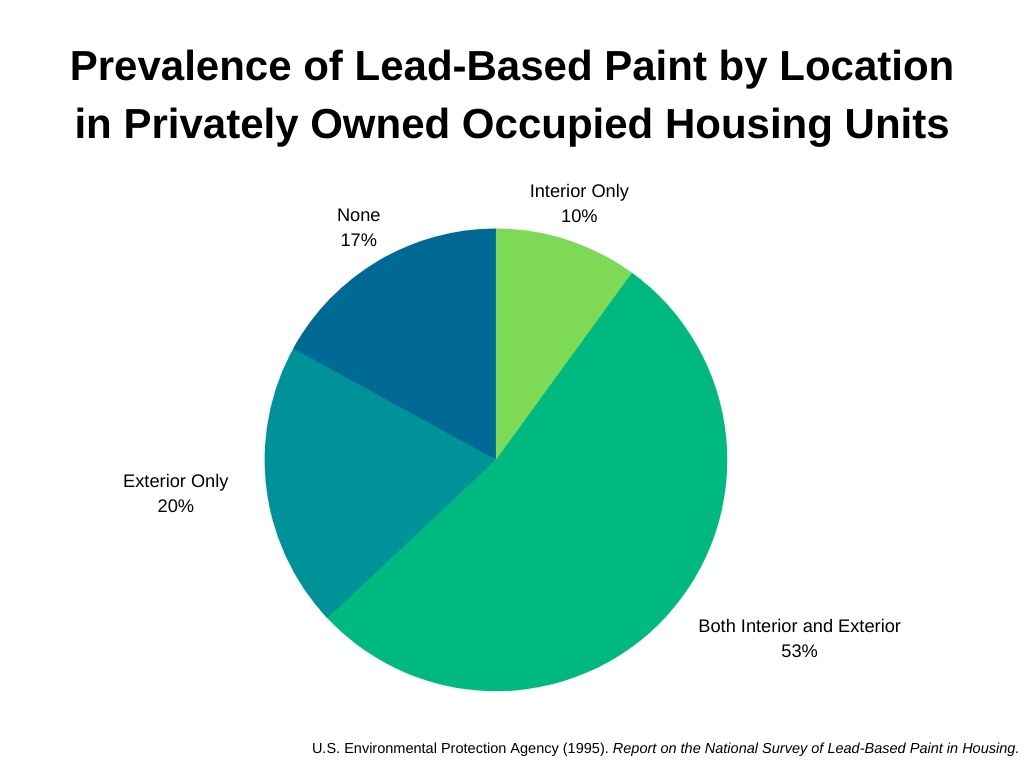When it comes time to renovate your property, whether residential or commercial, it’s crucial to understand the laws and regulations surrounding lead-based paint and construction products. Lead is an extremely hazardous substance that can cause irreparable damage to humans and household pets.
Before buying, selling, renting, or renovating, learn about the importance of safe, certified lead abatement and construction.
Why Do We Need Lead Laws?
Before the 20th century, the use of lead-based paint was prevalent in art and construction. Despite a few significant warnings from prominent scientists and public servants throughout the early history of lead paint use, people were not generally aware of the health risks associated with the chemical element.
Symptoms of Lead Poisoning
Lead poisoning is a severe condition that causes various health problems in children and adults. While it is a naturally occurring element, once ingested or inhaled, a wide range of painful and concerning symptoms can arise, including:
- Developmental delays
- Learning difficulties
- Memory loss
- Fatigue
- Hearing and vision loss
- Seizures
- Infertility
- Vomiting
- Death
Ingesting or inhaling lead from paint chips or dust is extremely toxic and can lead to numerous health issues and even death. Once legislators recognized that severe health issues were arising in occupants of residential and commercial properties containing lead-based paint and building materials, they defined stringent laws and regulations in many countries.
In the United States, federal law requires all contractors who disturb painted surfaces built before 1978 to be certified and follow specific best practices to prevent possible lead contamination.
Lead Laws for Residential Properties
If you plan to renovate your existing home or consider buying a new one, inform yourself of lead laws and safety precautions before you begin your project or search.
The Banning of Lead Paint
While other countries in Europe and North America were banning the use of the toxic substance in construction as early as 1909, the United States did not conform to safety standards until the late 20th century.
Finally, in the 1970s, the U.S. implemented two laws within six years of each other regulating the use of lead-based paint in new construction:
1971: U.S. Congress bans the use of lead-based paint in federally funded residential and commercial construction projects.
1977: The U.S. Product Safety Commission bans the use of lead-based paint in newly built residential and commercial buildings entirely.
The U.S. Environmental Protection Agency (EPA) estimated in it’s Comprehensible and Workable Plan (CWP) that 64 million private homes built before 1980 contain traces of lead. That’s 83% of all homes built before that year!

Even with the banning of lead paint, there is still a high chance that your current or future home could contain lead paint or particles if built before the 1970s. Luckily, sellers must inform buyers of the presence of lead-based paint during the purchase process.
1996 Lead-Based Paint Disclosure Act
Whether you’re buying or selling a residential property, this piece of legislation is critical to remember. The 1996 Lead-Based Paint Disclosure Act, implemented by the EPA and the Department of Housing and Urban Development, ensures that the presence of lead-based paint in homes built before 1978 is disclosed to potential buyers or renters.
As a buyer, do not ignore this piece of legislation, as it benefits you significantly. The presence of lead-based paint can be a matter of life and death, so be sure to hire a certified lead inspector or lead risk assessor to give you peace of mind when purchasing a new property.
Unfortunately, rental property managers are not required to disclose this information. However, a stipulation can usually be found in leasing agreements revealing the possibility of the presence of lead in the apartment to minimize the risk of any liabilities in the future.
Lead Laws for Commercial Properties
Like residential properties, commercial buildings also have to follow the rules and regulations regarding lead-based paint and construction materials put in place by the EPA and other federal agencies.
2010 EPA Renovation, Repair, and Painting Regulations (RRP)
One of the more recent developments in lead-related illness prevention is the implementation of the 2010 EPA Renovation, Repair, and Painting Regulations, or RRP. Contractors must comply with the extensive rules and regulations to avoid the potential for code violations and hefty fines.
The EPA’s Lead-Safe Certified Guide to Renovate Right outlines the following rules for contractors to follow while working with lead-based materials:
- Establish a safe alternative living space for occupants and their pets
- Establish a separate pathway for contractors to get in and out of the building to avoid tracking lead particles
- All heating and air conditioning must be turned off during construction
- Contain the work area by covering floors and sealing off doors
- Avoid open flame burning, torching, sanding, grinding, or blasting with power tools
- Use a HEPA vacuum to clean up dust and debris each day
- Wet and wipe down surfaces with clean water each day
1996 Lead-Based Paint Disclosure Act
Just like in a residential building, owners of commercial properties must also disclose the presence of lead so long as they are selling the property. However, if they are only renting or leasing the space, they are not required to share that information with potential occupants. That is why it is crucial to hire an EPA-certified lead inspector to confirm the space’s safe occupancy.
Certifications Guarantee Safe Construction
The presence of lead-based products in many older homes and buildings has changed how contractors operate during renovations. The EPA requires certifications to ensure that contractors and other construction workers protect themselves and the occupants of the home from dangerous lead particles.
The abatement, or removal, of lead-based paint and other materials, is incredibly dangerous if not completed correctly. Hiring a certified lead abatement or renovation specialist guarantees that your residential home or commercial building renovation is finished safely and according to the law. Construction workers and supervisors are responsible for continually renewing certifications, and there can be serious repercussions if the regulations put in place by the EPA are not followed strictly.
Educate yourself on the laws and regulations of lead-based paint and materials used in residential and commercial construction. Work with a certified lead renovator to make your dream project a reality while keeping yourself, your family, and the construction crew you hire safe.


